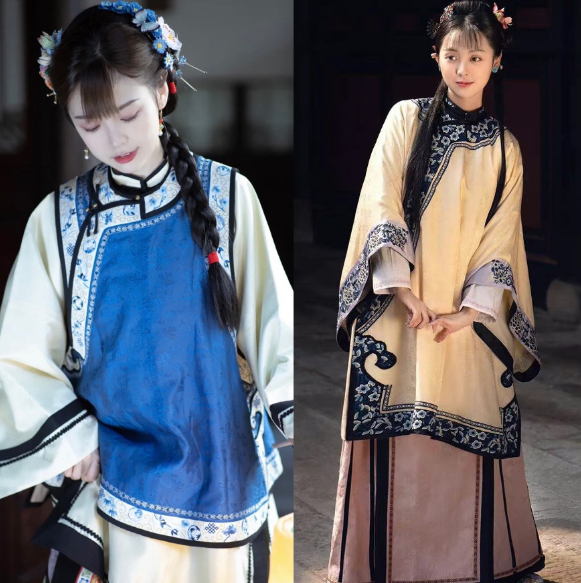Qing Dynasty Hanfu patterns were symbolic of status, beliefs, and cultural values, often reflecting the wearer’s rank and societal role.
Historical Context of Qing Dynasty Hanfu
Emergence and Evolution of Hanfu in Qing Dynasty
In the vibrant history of the Qing Dynasty, Hanfu, the traditional Chinese attire, underwent a remarkable evolution. Initially, the Manchu rule introduced their clothing styles, but Hanfu preserved its distinct identity while embracing subtle Manchu influences. This period saw Hanfu maintaining its traditional form, yet slowly adopting narrower sleeves and higher collars, mirroring the Manchu fashion.
As the Qing Dynasty flourished, especially during the prosperous reign of Emperor Qianlong, Hanfu transformed significantly. It evolved from its earlier simplicity to a more ornate and elaborate style, showcasing intricate embroidery and luxurious fabrics. These changes in Hanfu not only represented fashion trends but also mirrored the era’s socio-cultural landscape, reflecting the wearer’s social status and wealth.
This evolution of Hanfu during the Qing Dynasty paints a vivid picture of the period’s identity, politics, and artistic expression, offering a deep insight into one of China’s most influential historical phases.

Influence of Political and Cultural Shifts on Hanfu Designs
The Qing Dynasty’s political and cultural shifts, particularly the Manchu conquest, brought a fusion of Han and Manchu cultures, significantly influencing Hanfu designs. The Qipao, originally a Manchu dress, became a symbol of this cultural amalgamation, gradually integrating into the Hanfu wardrobe, especially among Han Chinese women.
Qing Dynasty’s increased interaction with Western nations introduced new materials and styles into Hanfu designs. Traditional silk began to be complemented with Western fabrics like velvet and lace, marking an aesthetic transition and China’s growing involvement in global trade and cultural exchanges.
This adaptation of Hanfu to the era’s political and cultural changes highlights the clothing’s resilience and versatility, transforming it into a medium for artistic expression. It reflects the rich and diverse history of China, illustrating how traditional attire can offer insights into the nation’s socio-political journey.
Exploring the historical context of Qing Dynasty Hanfu uncovers a narrative rich in cultural identity, adaptation, and artistic innovation. It provides a unique perspective on the interplay between traditional attire and broader socio-political dynamics, enriching our understanding of Chinese history’s complex tapestry.
Symbolism in Qing Dynasty Hanfu Patterns
Analysis of Common Patterns and Their Meanings
In the rich tapestry of Qing Dynasty Hanfu, each pattern carries a deep symbolic meaning, often derived from ancient Chinese beliefs and legends. For instance, the dragon, a predominant motif, symbolizes power and imperial authority. Emperors exclusively wore robes adorned with dragon patterns, often depicted amidst clouds to represent the celestial and divine power of the ruler.
Another common motif is the phoenix, representing grace and high virtue. In Hanfu, the phoenix often appears in conjunction with the dragon, symbolizing a harmonious balance between yin and yang, female and male energies. This combination was particularly popular in wedding Hanfu, encapsulating wishes for a balanced and blissful marriage.
Floral patterns, such as peonies and chrysanthemums, also feature prominently in Hanfu. The peony, known as the ‘king of flowers’, symbolizes wealth and honor, while chrysanthemums represent longevity and resilience. These floral motifs not only add aesthetic appeal but also convey messages of prosperity and good fortune.
This deep-rooted symbolism in Hanfu patterns reflects the Chinese cultural emphasis on conveying profound meanings through art and attire, illustrating a unique blend of aesthetic beauty and philosophical depth.
Role of Colors and Fabrics in Symbolism
Colors and fabrics in Qing Dynasty Hanfu play a crucial role in conveying symbolic meanings. Red, a dominant color in Chinese culture, symbolizes good fortune and joy. In Hanfu, red is often used for festival and wedding attire, embodying a sense of celebration and happiness.
Yellow, traditionally reserved for the emperor, represents power, royalty, and prosperity. It was often used in imperial Hanfu, made from the finest silk, to underscore the emperor’s supreme status. The use of yellow in Hanfu was strictly regulated, highlighting its significance in the social hierarchy of the time.
The choice of fabric also carried symbolic weight. Silk, revered for its smooth texture and lustrous appearance, symbolized wealth and high social status. Silk Hanfu was a mark of nobility, often intricately embroidered with gold and silver threads to enhance its elegance.
The symbolism embedded in the colors and fabrics of Qing Dynasty Hanfu offers a fascinating insight into the cultural values and social structures of the era. It reflects the intricate relationship between attire, identity, and societal norms, showcasing the sophistication and depth of traditional Chinese clothing.
Through this detailed examination of Hanfu patterns and their symbolism, we gain a profound understanding of the cultural richness of the Qing Dynasty. It reveals how traditional Chinese attire serves as a canvas for expressing complex societal values and beliefs, enhancing our appreciation for this exquisite aspect of Chinese heritage.
Societal and Class Implications of Hanfu Patterns
Differentiation of Social Classes Through Hanfu Designs
In the structured society of the Qing Dynasty, Hanfu vividly distinguished social classes. Imperial Hanfu stood at the apex, exclusively worn by the emperor and his family. These garments featured elaborate dragon patterns and utilized the finest silk, symbolizing the zenith of authority and status. The distinction was so pronounced that only the royal family had the privilege of wearing five-clawed dragons, a design that underscored their exclusive right to this powerful symbol.
Descending the social ladder, the nobility and high-ranking officials donned Hanfu that, while still luxurious, was less extravagant than the imperial attire. These garments, featuring simpler dragon patterns and high-quality silk, subtly indicated their elevated but not sovereign status. In stark contrast, civilian Hanfu embodied simplicity and affordability. Common people faced strict prohibitions against using certain colors and motifs, like yellow and dragons, maintaining a clear visual boundary between them and the higher echelons of society.
This stratification in Hanfu designs not only reinforced the social hierarchy but also reflected the deeply ingrained Confucian ideals of order and rank. It highlights the role of clothing as a potent symbol of social positioning, illustrating the complex structures and norms of Qing society.
Hanfu as a Marker of Cultural Identity and Status
Beyond its functional role, Hanfu emerged as a profound symbol of cultural identity and social status. For the scholars and literati, their choice of Hanfu was a testament to their intellectual and moral stature. Opting for understated, refined patterns, these garments mirrored their dedication to knowledge and virtue.
During traditional Chinese festivals and ceremonies, Hanfu became a canvas for cultural expression. People donned specific styles to demonstrate respect and engagement in these cultural practices. Notably, the Lunar New Year saw many embracing new Hanfu, symbolizing renewal and the ushering in of prosperity.
In the broader context of the Manchu rule, Hanfu took on an added dimension as a marker of ethnic identity for the Han people. By adhering to their traditional dress, they maintained a sense of cultural continuity and identity, subtly resisting the imposition of Manchu styles.
The intricate interplay between Hanfu and societal dynamics in the Qing Dynasty unveils a culture deeply rooted in symbolism and hierarchy. This exploration into the societal implications of Hanfu enriches our understanding of how traditional attire can embody and convey complex social narratives, reflecting the rich cultural and historical fabric of a society.

Ceremonial and Ritual Significance of Hanfu Patterns
Hanfu in Royal Ceremonies and Public Festivals
In the rich tapestry of Chinese culture, Hanfu has always played a pivotal role in royal ceremonies and public festivals, embodying both grandeur and tradition. During imperial coronations, the emperor’s Hanfu would be a spectacular display of authority and divine right, often adorned with intricate dragon patterns and made from the finest silk, to symbolize the celestial mandate to rule. These garments were not just clothing; they were emblematic of power and the continuity of the dynasty.
Public festivals also saw a vibrant display of Hanfu, with each festival having specific attire associated with it. For instance, the Lunar New Year celebrations would see people donning brightly colored Hanfu, often with embroidered motifs of prosperity and good fortune, like fish or lotus flowers. The Mid-Autumn Festival, on the other hand, had Hanfu with moon and star motifs, reflecting the festival’s celestial theme.
This integration of Hanfu into ceremonial and festival attire reveals a deep connection between clothing and cultural expression, showcasing how traditional attire plays a crucial role in the celebration and perpetuation of cultural heritage.
Interpretation of Ritualistic Symbols in Hanfu
Hanfu patterns are not merely decorative; they carry profound ritualistic meanings that are deeply ingrained in Chinese culture. For example, the use of crane motifs in Hanfu is often associated with longevity and wisdom, a common theme in many Chinese rituals. Similarly, the incorporation of lotus patterns symbolizes purity and spiritual enlightenment, often used in religious ceremonies.
Wedding Hanfu, in particular, showcases a plethora of symbols meant to convey blessings for the couple. The double happiness character, phoenix and dragon motifs, and red color predominant in wedding Hanfu are all deeply symbolic, wishing the newlyweds a life of happiness, harmony, and prosperity.
Through the interpretation of these ritualistic symbols, Hanfu becomes a medium of cultural storytelling, conveying ancient beliefs and customs. This aspect of Hanfu underscores its significance beyond mere attire, positioning it as a crucial element in the tapestry of Chinese ritualistic and ceremonial practices.
The exploration into the ceremonial and ritual significance of Hanfu patterns opens a window into the soul of Chinese traditions. It highlights the depth and richness of cultural symbolism in traditional attire, offering a colorful glimpse into the historical and cultural ethos of China.








